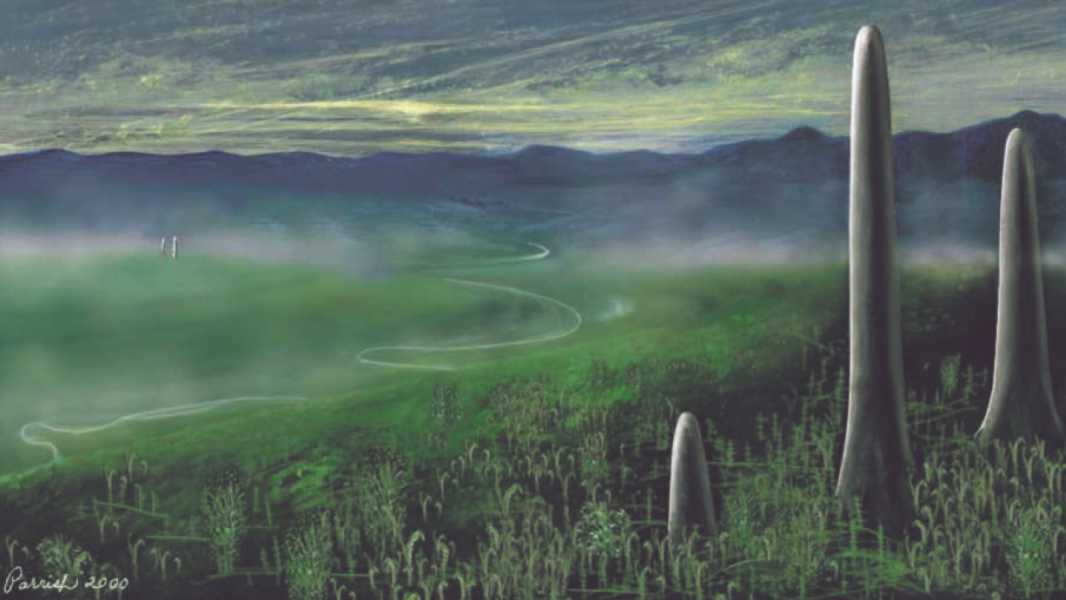
A drawing showing what Prototaxites might have looked like 400 million years ago. (Image credit: Painting by Mary Parrish, National Museum of Natural History.)
A strange ancient life form thought to be the first large organism to live on land may belong to an entirely unknown branch of the tree of life, researchers say.
These organisms, known as Prototaxites, lived approximately 420 to 375 million years ago during the Devonian period and looked like cylindrical tree trunks with no branches. These creatures were huge, with some species reaching 26 feet (8 meters) tall and 3 feet (1 meter) wide.
Since the first Prototaxites fossil was discovered in 1843, scientists have been unable to determine whether they were a plant, a fungus, or even a type of algae. However, a chemical analysis of Prototaxites fossils in 2007 showed that they were likely a giant ancient fungus.
Now, according to a paper posted March 17 on the preprint server bioRxiv, Prototaxites may not have been a giant fungus — rather, it may have been an entirely different, previously unknown life form. The study has not yet been peer-reviewed.
All life on Earth is classified into three domains—bacteria, archaea, and eukaryotes—with eukaryotes including all multicellular organisms within the four kingdoms of fungi, animals, plants, and protozoa. Bacteria and archaea contain only single-celled organisms.
Previous chemical analysis of Prototaxites fossils has shown that they likely fed on decaying organisms, like many modern fungi, rather than extracting food from carbon dioxide in the air like plants.
However, according to a new study, Prototaxites may actually have belonged to an entirely different kingdom of life, distinct from fungi, plants, animals, and protists.
The researchers studied the fossilized remains of one Prototaxites species, called Prototaxites taiti, found in the Rhynie Flint, a sedimentary deposit that preserves exceptionally well the fossils of early land plants and animals in Scotland. This species was considerably smaller than many other Prototaxites species, standing only a few inches tall, but it is still the largest Prototaxites specimen found in the region.
After studying the internal structure of the fossilized Prototaxites, the researchers noticed that their interiors were made up of many tubes, similar to those found inside mushrooms. However, these tubes branched and reconnected in ways that were very different from those seen in modern mushrooms.
“We report that Prototaxites taiti was the largest organism in the Rhynie ecosystem, and its anatomy was fundamentally different from all known extant or extinct fungi,” the researchers wrote in the paper. “We therefore conclude that Prototaxites was not a fungus, and instead propose that it belongs to an entirely extinct terrestrial lineage.”
Real fungi from the same period were also preserved in the Rhynie chert, allowing the researchers to compare them chemically to Prototaxites. In addition to their unique structural characteristics, the team found that Prototaxites fossils left behind very different chemical signatures compared to fungal fossils, indicating that Prototaxites did not contain chitin, the basic building block of fungal cell walls and a hallmark of the fungal kingdom. Instead, Prototaxites fossils appear to have contained chemicals similar to lignin, which is found in wood and plant bark.
“We conclude that the morphology and molecular fingerprints of P. taiti are distinctly different from those of the fungi and other organisms preserved with it in the Rhynie chert, and propose that it be considered
Sourse: www.livescience.com





